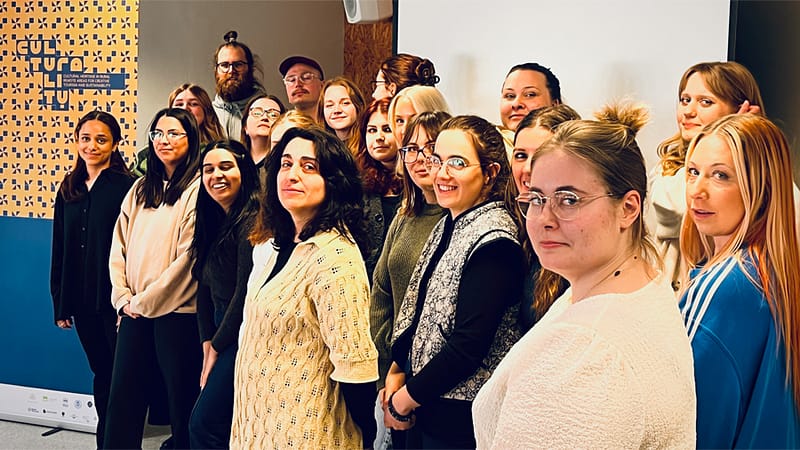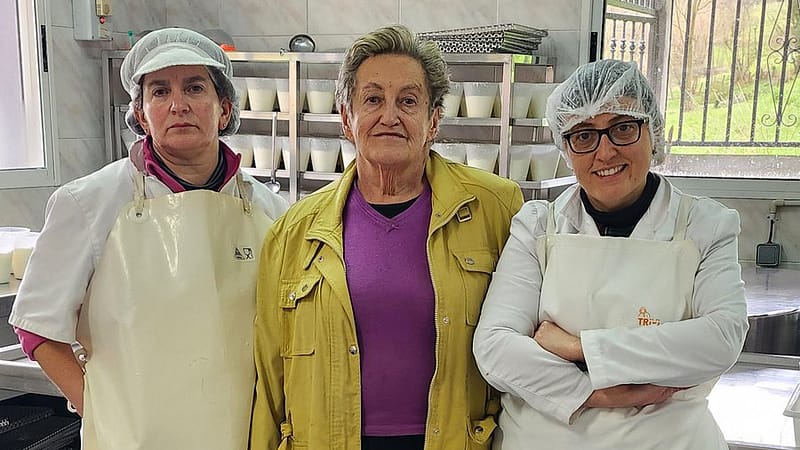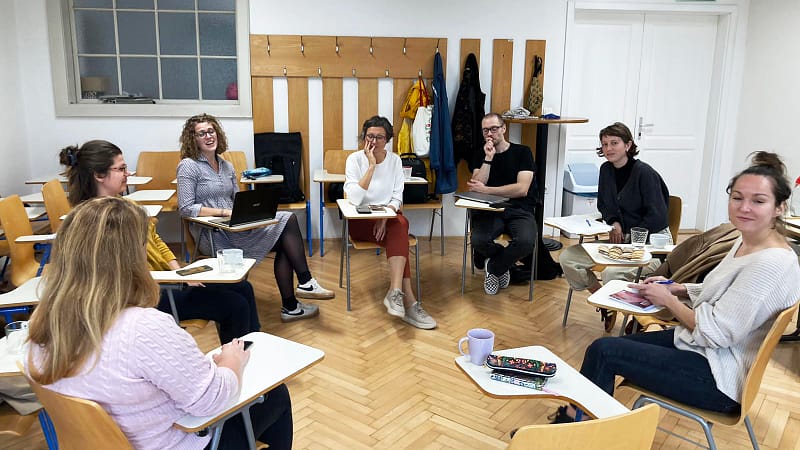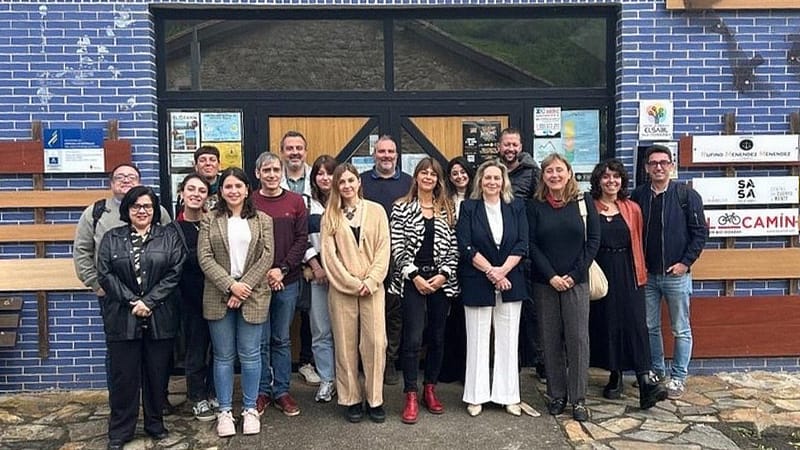Presentation at Brobygrafiska Students: Exploring Värmland’s Cultural Crafts

News & events Presentation at Brobygrafiska Students: Exploring Värmland’s Cultural Crafts As part of the CULTURALITY project’s mission to promote cultural heritage through digital innovation, students at Brobygrafiska have collaborated with Region Värmland to design a prototype for a story-driven digital platform. Focused on showcasing local artisans and craftsmen, the project blends branding, storytelling, and UX design to explore how digital tools can support rural cultural tourism. Digital story-driven platform is created in collaboration with Brobygrafiska During seven intensive weeks, about twenty students who study Digital Design at Brobygrafiska have worked on an assignment prepared together with Region Värmland. It is about developing a prototype for an interactive digital story-driven platform that lifts artisans and craftsmen in Värmland. Film developer Stefan Barkman tells how it happened. “Part of the Culturality project is about digital resources for research, outreach and collaboration. After collecting materials and some testing, we realized the need to involve UX design in the process. We contacted the Digital design teacher at Brobygrafiska who understood our entrance and we began a fruitful collaboration.” Assignment to students Jonathan Rist Christensen, teacher in Digital Design at Brobygrafiska explains how they took on the assignment. “The students were given an open brief about creating a digital platform to promote Värmland’s cultural crafts, with tourists as the target group. The focus was on finding a solution that would benefit and be used by the target group, depending on the concept they came up with. The project began with research to understand the target group and their origins. With the help of reports and statistics from Visit Värmland, they were able to identify different target groups based on their concepts. Then followed an iterative process to develop the solution, with many hours of hand-drawn wire sketches that were then transformed in Figma into a clickable prototype. In addition to this, students also had to create a brand to connect with the storytelling and communicate with the target audience in the right way.” Many creative ideas On April 8th, Stefan Barkman and Kajsa Stinnerbom, Region Värmland, together with representatives from Visit Värmland and Compare, were on site in Sunne to take part in the results of six groups’ creation of different creative platforms. “Great work from the students, it was very interesting to take part in all the groups’ presentations. It came with many exciting angles and solutions. We gained insight into how digital design for interactive platforms works and what opportunities they bring, as well as the importance of the aesthetic work behind such a product,” says Stefan Barkman. Develop a digital platform and storytelling Jonathan Rist Christensen further develops the reasoning how branding and storytelling are connected. “For us at Brobygrafiska, branding and storytelling go hand in hand. If you don’t know how to tell something, there may not be much to tell. When the brand has a clear core of values, storytelling becomes much easier as it becomes an extension of the brand as a personality.” Jonathan emphasizes what is important when developing a digital platform. “A digital platform needs to be accessible, adaptable and user-friendly. Our job as digital designers is not only about reducing frustrations but also about delivering an enjoyable experience. Here we use storytelling to our advantage. Digital storytelling is already interactive by its very nature. What we can then add and connect to strengthens the target group’s relationship with the brand if it is implemented in the right way. Similarly, you get the opposite effect if it is implemented in the wrong way.” Alstret (Created by a student group at Brobygrafiska) Nordic Atelier (Created by a student group at Brobygrafiska) Levande verk (Created by a student group at Brobygrafiska) Share with:
Third CULTURALITY Consortium Meeting

News & events THIRD CULTURALITY CONSORTIUM MEETING The CULTURALITY project partners gathered once again—this time in the picturesque capital of Slovenia—for the third Consortium Meeting, held from March 24th to 28th, 2025. The meeting was hosted by ZRC SAZU at the Geographical Museum, with sessions taking place in the Gosposka and Križevniška Halls—right in the heart of Ljubljana’s historic centre. Just a short walk from the Ljubljanica river and surrounded by lively cafés, local restaurants, and charming hotels, the venue offered an ideal setting for meaningful discussions and intercultural exchange. The five-day meeting focused on consolidating the project’s progress and strengthening the collaborative dynamic between partners. A full day was dedicated to Work Package (WP) presentations, where leaders of WPs 1 to 8 each delivered 30-minute reports. These presentations covered the work accomplished during the project’s first year and outlined strategic plans for the next six months. In addition to the WP sessions, a Steering Committee Meeting was held to discuss key administrative and operational matters, review the project timeline, and ensure continued alignment across the consortium. Participants also took part in a rich cultural and creative programme, including guided visits to Center ROG, Ljubljana’s new hub for creative industries and maker culture, and the Slovene Ethnographic Museum, a key institution for understanding Slovenia’s diverse cultural heritage. These visits offered valuable insights into local practices of cultural preservation, innovation, and community engagement—central themes within the CULTURALITY project.To conclude the week, partners enjoyed an excursion to the Škofja Loka area, the future location of the Slovenian Rural Event. The visit allowed participants to explore the rural cultural landscape firsthand, connecting deeply with the people and traditions that inspire CULTURALITY’s mission to foster sustainable cultural tourism and creative rural development.As the project moves into its next phase, the Ljubljana meeting marked a renewed commitment to collaboration, innovation, and cultural sustainability across Europe’s rural and remote regions. presentation_Ana presentation_Tartu presentation_UOviedo presentation_STAndrews Audience visit7 visit6 Hands_on2 Hands_on1 visit4 visit3 visit5 visit2 visit1 Hands_on3 Share with:
Third meeting of Slovenian crafts researchers

News & events Third meeting of Slovenian crafts researchers: Social and therapeutic aspects of handicrafts On February 11, 2025, ethnologists involved in crafts-related projects (Culturality, Commheritour, and Alptextiles), coming from the Department of Ethnology and Cultural Anthropology FA UL, Slovene Ethnographic Museum, and ZRC SAZU, continued their regular meetings to discuss the potentials and challenges of handicrafts research. They resumed the debate on the social dimensions of handicrafts, a key topic in previous meetings.Participants delved into the therapeutic benefits of engaging in craft activities and examined cases where individuals with special needs are included in handicraft programs within institutional care settings. A significant portion of the discussion centered on funding mechanisms for therapeutic and social initiatives, which often do not align with the ambitions of the cultural and creative industries to leverage crafts for economic development. The researchers emphasized the necessity of cross-sectoral collaboration involving the ministries of social affairs, health, and culture.Additionally, the researchers explored the importance of accessible learning materials and instructional resources for handicrafts, such as the Manual on Basketry, which provides step-by-step guidance on traditional crafts. These materials were recognized as valuable tools for engaging a wider audience and ensuring the preservation and transmission of traditional skills. The Slovene Ethnographic Museum is currently awaiting funding approval to begin visually documenting handicrafts in Slovenia, with the recordings to be conducted by the the Avdiovisual Laboratory of the Institute of Slovenian Ethnology at ZRC SAZU.The third meeting once again underscored the importance of a holistic approach to handicrafts, integrating social welfare, health, cultural and economic sectors to foster inclusive and sustainable community and spatial development. Photos by Saša Poljak Istenič Share with: Artigo anterior
Start-up with Broby grafiska students

News & events Start-up with Broby grafiska students: Exploring Värmland’s Cultural Crafts Late February marked the launch of the testbed “Värmland Cultural Crafts”, a CULTURALITY activity developed in collaboration with students from Broby Grafiska’s Digital Design and Design Systems program. The initiative, designed as a group assignment, was introduced yesterday by their teacher, Jonatan Rist Christensen.The challenge for the students is to work with existing audiovisual materials—while also integrating new elements if needed—to develop a brand identity that promotes cultural crafts to tourists . Their solutions should focus on: • Keeping the visitor on the page/platform with storytelling and interactivity.• Opportunity to experience the craft in the most immersive way possible. Culturality partners Stefan and Kajsa answering students’ questions. Broby grafiska is a graphic design school in Sunne. The profile “digital designer” is a 2 years vocational education and training. A challenge for the students was to decide what kind of platform this should be. The students had the opportunity to participate in shaping how they want to highlight the material, what material would be used, what material might be missing and how this could be built on for future use. The assignment lasts for 8 weeks after which the students will deliver a folder with: A Figma file with: Desktop version Mobile version Design system/UI kit Any presentation file Share with: Artigo anteriorArtigo seguinte
Fieldwork for WP2 Underway with UNIOVI Team

News & events Fieldwork for WP2 Underway with UNIOVI Team The fieldwork for Work Package 2 (WP2) has officially begun, led by the University of Oviedo (UNIOVI) team. Santiago Rodríguez Pérez, coordinator of the fieldwork, accompanied by Lucía Pérez, visited Marta Fernández Martínez, the owner of the traditional cheese factory Ca Sanchu, on Thursday, 30 January. During the visit, all procedures outlined in the guidelines for this task were strictly followed. Marta Fernández Martínez provided a detailed explanation of the production process for the artisanal Asturian cheese “Afuega’l Pitu.” Her insights contributed valuable knowledge to the research, ensuring a comprehensive understanding of traditional cheese-making techniques. This visit marks an important step in the WP2 research process, reinforcing the commitment to preserving and documenting Asturias’ rich cultural and gastronomic heritage. The owner, her only worker and her mother The owner, her only worker and her mother Quesos de trapu Quesos de trapu Marta Fernandez Martinez giving her explanation of the process Marta Fernandez Martinez giving her explanation of the process Santiago Rodríguez (CULTURALITY) carrying out the interview Santiago Rodríguez (CULTURALITY) carrying out the interview Share with:
CULTURALITY Project Strengthens Local Ties in Asturias

News & events CULTURALITY Project Strengthens Local Ties in Asturias On 31 December, all Asturian partners of the CULTURALITY project gathered for a pivotal meeting with the Local Action Managers (GAL) from six regions of Asturias. Organised jointly by ESPTOR and the University of Oviedo (UNIOVI), the event served as a crucial step in fostering collaboration and strengthening regional networks. The meeting provided a platform for attendees to introduce themselves, become acquainted with one another, and exchange perspectives and aspirations regarding the project. Ana María Fernández García, the project’s Principal Investigator (IP), delivered an introductory presentation outlining the specific objectives pursued through this initiative. Following this, the Work Packages (WPs) led by the attending partners were detailed before the floor was opened for discussion and dialogue. The exchange of ideas and insights among stakeholders was highly constructive, with participants expressing optimism about the potential collaborations that could emerge from this gathering. The discussions underscored the shared commitment to promoting cultural heritage in rural areas through sustainable and creative tourism initiatives. The CULTURALITY project continues to build strong foundations for cooperation, with this meeting marking an important milestone in fostering regional engagement and strategic partnerships in Asturias. The organisers and attendees alike anticipate that the synergies created during the session will lead to valuable joint efforts in the future. Share with:
Meeting with deputy minister for crafts

News & events Meeting with deputy minister for crafts The members of the coordinating team of the European CULTURALITY project, Ana María Fernández García and Llara Fuente Corripio, meet in Oviedo with the regional government’s deputy minister for crafts. This meeting was of crucial importance to establish avenues for future means of collaboration. It will allow both the local government and the researchers involved in the project to explore synergies between the public administration and the local development initiatives that are being promoted. In addition, it opens the door to the creation of new opportunities for institutional support, both for the preservation of traditional crafts and for the implementation of innovative business models in rural areas. This encounter can strengthen the impact and sustainability of the project in the long term, ensuring the support and assistance of public administration. Share with: Artigo anteriorArtigo seguinte
CULTURALITY, Commheritour and Alptextiles ethnologists meet in Ljubljana

News & events CULTURALITY, Commheritour and Alptextiles ethnologists meet in Ljubljana On October 8, 2024, the ethnologists involved in handicraft-related projects #Culturality, #Commheritour and #Alptextiles met at the Department of Ethnology and Cultural Anthropology FA UL in Ljubljana, Slovenia, to discuss the potentials and challenges of research and study of handicrafts. The meeting connected key players in the field of craftsmanship: besides the Department also Center DUO Škofja Loka and ZRC SAZU. It allowed researchers of the latter to align the goals of the CULTURALITY project with the broader reflections in the field. The meeting offered a platform for sharing the latest findings, methods, and challenges encountered by different teams, including the criteria of good practices in handicrafts developed by the CULTURALITY’s project partner La Ponte Ecomuseu. The networking underlined potential for future collaborations which could enhance the scope of the CULTURALITY project and maximize its impact on a regional and international scale. Understanding the scope of various projects involving heritage experts has helped ZRC SAZU to identify potential areas for collaboration and prevent the duplication of efforts. The meetings will continue to further enhance the cooperation among different teams and the promotion of the handicrafts, especially in remote rural areas in need of the development of economic activities, including tourism. Photo by: Katarina Šrimpf Vendramin Share with: Artigo anteriorArtigo seguinte
CULTURALITY inspires International collaboration to revalue handmade footwear

News & events CULTURALITY inspires International collaboration to revalue handmade footwear Pedro Carvalho de Almeida, a Portuguese designer and professor at the University of Aveiro, has embarked on an exciting collaboration with the Biomimetic Laboratory of Ladines (Sobrescobio) and textile workshop Paz Mesa from Las Regueras. The initiative aims to update and revalue Portugal’s artisan shoe brands by blending traditional craftsmanship with innovative materials and design techniques. During the collaboration, Carvalho de Almeida created several prototypes of clogs and slippers, working closely with Paz Mesa, who specializes in textiles made from the wool of xalda sheep, a native Asturian breed. This project, developed at the Biomimetic Laboratory led by Marlén López and Manuel Persa, draws on research into new materials made from natural resources and designs inspired by nature. Notably, they contributed a unique material for the shoe soles, crafted from chestnut shells, reinterpreting traditional Portuguese footwear with an eco-friendly twist.Part of this innovative process is carried out in collaboration with the “Centro Tecnológico do Calçado de Portugal” (CTCP), where new solutions and materials are tested and implemented to ensure practicality and sustainability in modern footwear production. This collaboration was born out of the network established by the partners of the CULTURALITY project, specifically following the inaugural “Creators & Keepers” exhibition, which focused on the heritage of craftsmanship and its modern applications. The project’s influence has sparked cross-border collaborations, furthering the revival of traditional crafts and connecting artisans, designers, and researchers. Read the full article published by the Asturias Exterior newspaper at: https://www.lne.es/asturias-exterior/2024/09/05/mal-calza-portugal-lllegan-zapatillas-107777827.html Share with: Artigo anterior
La Ponte meeting

News & events LA Ponte meeting The Spanish partners of the European CULTURALITY project met this Wednesday, June 12, at the El Sabil Business Center (Santo Adriano) to discuss the progress made since the Kick-Off Meeting last April and to coordinate their future actions in the short and medium term. Apart from the regular participants —the UNIOVI, UriaXait, La Ponte-Ecomuséu and Espacio Tormaleo teams—, we also had the presence of two special guests: Cristina López Santa Cruz, local development agent, and Elvira Menéndez Fernández, mayor of the council. Among the main topics to be discussed were both the necessary prior preparations in order to begin the field work and the organization of the first public events related to the project. IMG_20220528_181119 IMG_20230506_194121 366382062_669524301878090_711328236870566708_n IMG_20220528_165152 Share with:

